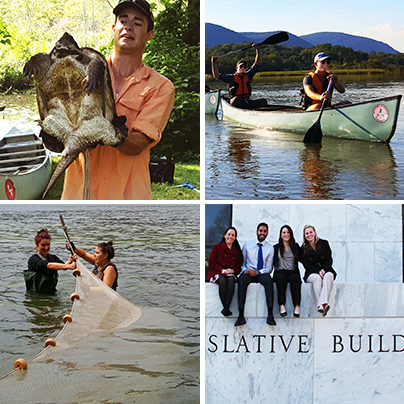
Swan Lake, Rockefeller State Park Preserve. Emma Weis (2016)
Public parks and other green spaces provide critical opportunities and resources for both people and nonhuman nature. In the summer of 2016, faculty and students from Pace University’s Environmental Studies and Science program worked closely with the Rockefeller State Park Preserve to design and implement the Rockefeller Trail Use Project, which studies how people use and value park spaces. During June and July – when park use was at its highest – Environmental Studies student Emma Weis conducted field surveys that assessed trail use and brief interviews that explored perceptions of the park and it’s trails. Over the course of eight days Weis conducted 89 surveys with park visitors. This information provided a general understanding of park experiences and the values users derive from Rockefeller.
Parks like the Rockefeller State Park Preserve provide habitat for flora and fauna as well as important ecosystem services for humans. For example, trees help clean the air and unpaved landscapes help recharge groundwater or prevent flooding in nearby communities. Importantly, parks provide a refuge for humans – often in unquantifiable ways – that help them get away from the hustle and bustle of daily life. Park users often talk about this in terms of the “peace” or “serenity” they feel when visiting these public goods.
It would be an injustice if only certain people have access while others are excluded for reasons contrary to contemporary environmental values.
As public parks increase in popularity, many park managers are seeking better ways to safeguard access and use while protecting the resources that are so important to everything from humans to plants, animals, and biogeochemical cycles. Many parks in Westchester County provide these valuable resources, and The Rockefeller Preserve is one of our most cherished. The Rockefeller family, which originally used the property as a country retreat, installed a system of trails and aesthetically pleasing features such as plantings, waterways, and scenic vistas. Over time they donated the property to public uses, which visitors can access for a small fee. Today the Preserve is comprised of over 1,600 acres with 55 miles of carriage trails that support activities such as walking, running, horseback riding, cross country skiing, and snowshoeing (NYS Office of Parks, Recreation, and Historic Preservation, 2015; for more about the park visit Friendsrock.org).
An initial review of our summer field surveys in the Rockefeller Preserve clearly suggest that although the Preserve’s physical environment is a draw, users often said they visit the park specifically because it is a quiet, peaceful, and serene space. In many cases, the Preserve is viewed not only as an escape into nature but an escape from cities. These responses are supported by similar research, such as Svendsen, Campbell, and McMillen (2016), who identified clear “psycho-social-spiritual benefits of urban parklands” in New York City.
With this in mind, Weiss is pushing the project forward by considering issues of environmental justice and park access. In other words, does the Preserve truly provide opportunities for all segments of society to enjoy it? Although it is a public park, we wondered about the obstacles to access. For example, does one need a car to access the park? What other transportation options are available? And, does access comprise an environmental justice issue? In our view it would be an injustice if only certain people have access while others are excluded for reasons contrary to contemporary environmental values. Furthermore, justice must extend to nonhuman nature as well. So, how can access be increased while still protecting resources? These thorny questions compel society to take a deeper look into the sometimes-conflicting values of human benefits, public access, and resource protection.
Research for The Rockefeller Trail Use Project will continue into the fall. Working with our team, Weis will administer follow-up interviews with participants from the initial field surveys. These more in depth interviews will add nuance to our understanding of park uses, perceptions, and access. Additionally, she will explore the environmental justice issue as it relates to regional parks, using GIS as a spatial analytical tool. After the data is collected and analyzed, our work will ideally aid Rockefeller with their trail management strategies as well as support the growing literature regarding the importance of green space and its benefits to our socio-ecological systems.
Sources
NYS Office of Parks, Recreation, and Historic Preservation (2015) Rockefeller State Park Preserve. Retrieved from http://nysparks.com/parks/59/details.aspx
Svendsen, E. S., Campbell, L. K., & McMillen, H. (2016) Stories, shrines, and symbols: Recognizing psycho-social-spiritual benefits of urban parks and natural areas. Journal of Ethnobiology (in print).
«« »»
Emma Weis (2017) is an undergraduate Environmental Studies major at Pace University working with Dr. Michael Finewood, an assistant professor in the Department of Environmental Studies and Science. Dr. Finewood is a human geographer and political ecologist focused on environmental perception and decision-making.


